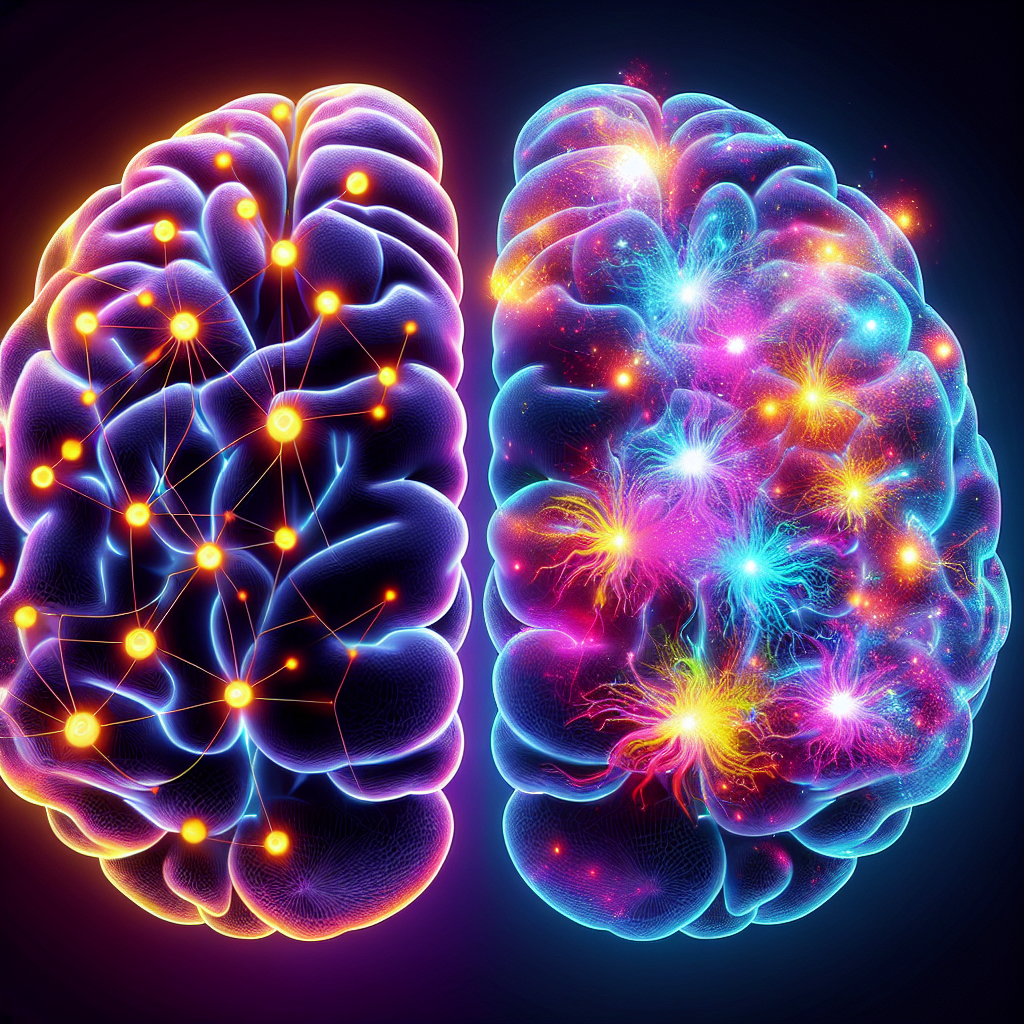-
Table of Contents

“Unlocking the Mind: The Profound and Complex Effects of LSD on Brain Function”
Introduction
Lysergic acid diethylamide (LSD) is a powerful hallucinogenic substance that significantly impacts brain function. When ingested, LSD primarily interacts with serotonin receptors, particularly the 5-HT2A receptor, leading to altered sensory perceptions, mood changes, and cognitive distortions. This interaction disrupts normal communication between brain regions, resulting in the characteristic visual and auditory hallucinations, as well as profound changes in thought processes and emotional states. Additionally, LSD can affect the default mode network (DMN), a brain network associated with self-referential thoughts and consciousness, potentially leading to a sense of ego dissolution or a feeling of oneness with the universe. These effects are typically temporary, but the intensity and nature of the experience can vary widely among users. Long-term impacts on brain function are still being studied, with some research suggesting potential therapeutic benefits for certain psychiatric conditions, while also acknowledging the risks of adverse psychological reactions.
Long-Term Cognitive Effects Of LSD On Brain Function
LSD, or lysergic acid diethylamide, is a powerful hallucinogenic drug that has fascinated scientists, artists, and the general public for decades. While its short-term effects on perception and consciousness are well-documented, the long-term cognitive effects of LSD on brain function are less understood. However, recent research has begun to shed light on how this substance can impact the brain over extended periods, offering both cautionary tales and glimmers of hope for its potential therapeutic uses.
One of the most significant long-term cognitive effects of LSD is its impact on neuroplasticity, the brain’s ability to reorganize itself by forming new neural connections. Studies have shown that LSD can enhance neuroplasticity, potentially leading to improved cognitive flexibility and creativity. This is particularly inspiring for those interested in the therapeutic applications of psychedelics, as enhanced neuroplasticity could help in treating conditions like depression, PTSD, and anxiety. By fostering new ways of thinking and breaking old patterns, LSD could offer a new avenue for mental health treatment.
However, it is essential to balance this optimism with caution. While enhanced neuroplasticity can be beneficial, it can also lead to maladaptive changes if not properly managed. For instance, some users report persistent changes in perception, such as visual disturbances or “trails” following moving objects, long after the drug has left their system. These symptoms, often referred to as Hallucinogen Persisting Perception Disorder (HPPD), can be distressing and disruptive to daily life. Therefore, while the potential for positive change exists, it is crucial to approach LSD use with a clear understanding of the risks involved.
Another area of interest is the impact of LSD on memory and learning. Some studies suggest that LSD can impair short-term memory, making it difficult for users to retain new information while under the influence. However, the long-term effects on memory are less clear. Some research indicates that repeated use of LSD could lead to subtle changes in memory function, although these changes are generally not severe. This nuanced understanding underscores the importance of responsible use and further research to fully comprehend the long-term implications.
Moreover, the social and emotional aspects of cognitive function are also influenced by LSD. Many users report a heightened sense of empathy and connectedness, which can have lasting positive effects on relationships and social interactions. This increased emotional openness can be particularly beneficial in therapeutic settings, where it may help individuals confront and process deep-seated emotional issues. However, it is also worth noting that these emotional effects can be overwhelming for some, leading to anxiety or emotional instability. As with any powerful substance, the key lies in careful, controlled use and ongoing research to maximize benefits while minimizing risks.
In conclusion, the long-term cognitive effects of LSD on brain function are complex and multifaceted. While there is promising evidence that LSD can enhance neuroplasticity, creativity, and emotional connectedness, there are also potential risks, including perceptual disturbances and memory impairment. As our understanding of this enigmatic substance continues to evolve, it is crucial to approach its use with both optimism and caution. By doing so, we can unlock its potential benefits while safeguarding against its risks, paving the way for a more informed and balanced perspective on this powerful psychedelic.
Neurotransmitter Alterations And Brain Connectivity Changes Due To LSD Use
LSD, or lysergic acid diethylamide, is a powerful hallucinogenic substance that has intrigued scientists and the public alike for decades. Its profound effects on perception, mood, and cognition are well-documented, but the underlying mechanisms by which LSD alters brain function are only beginning to be understood. One of the most significant ways LSD impacts the brain is through alterations in neurotransmitter activity and changes in brain connectivity. These changes can provide insights into the potential therapeutic uses of LSD, as well as the risks associated with its use.
At the core of LSD’s effects on the brain is its interaction with serotonin receptors, particularly the 5-HT2A receptor. Serotonin is a key neurotransmitter involved in regulating mood, perception, and cognition. When LSD binds to these receptors, it disrupts normal serotonin signaling, leading to the profound sensory and cognitive changes that characterize an LSD experience. This disruption can result in altered states of consciousness, including visual and auditory hallucinations, changes in thought patterns, and a sense of interconnectedness with the environment.
Moreover, LSD’s impact on serotonin receptors is not limited to a single brain region. Instead, it affects multiple areas, leading to widespread changes in brain connectivity. Functional magnetic resonance imaging (fMRI) studies have shown that LSD increases connectivity between brain regions that are typically segregated. This increased connectivity can lead to a breakdown of the usual boundaries between different sensory modalities and cognitive processes, contributing to the synesthetic experiences often reported by LSD users. For example, individuals might “see” sounds or “hear” colors, as the brain’s sensory pathways become more interconnected.
In addition to enhancing connectivity between disparate brain regions, LSD also appears to reduce connectivity within certain networks, such as the default mode network (DMN). The DMN is associated with self-referential thinking, daydreaming, and the sense of self. Under the influence of LSD, the activity within the DMN decreases, which can lead to a diminished sense of ego and an increased feeling of unity with the external world. This dissolution of the ego is often described as a profound and transformative experience, with some users reporting lasting changes in their perspective on life and their place in the universe.
The alterations in brain connectivity and neurotransmitter activity induced by LSD have significant implications for its potential therapeutic uses. For instance, the ability of LSD to disrupt rigid patterns of thought and behavior has led researchers to explore its use in treating conditions such as depression, anxiety, and post-traumatic stress disorder (PTSD). By facilitating a more flexible and interconnected brain state, LSD may help individuals break free from maladaptive thought patterns and gain new insights into their mental health challenges.
However, it is important to approach the use of LSD with caution. While the changes in brain function it induces can be profound and potentially therapeutic, they can also be unpredictable and overwhelming. The altered states of consciousness brought about by LSD can lead to intense emotional experiences, which may be difficult to integrate without proper support and guidance. Therefore, any therapeutic use of LSD should be conducted in a controlled and supervised setting, with careful consideration of the individual’s mental health history and current state.
In conclusion, LSD’s impact on brain function through alterations in neurotransmitter activity and changes in brain connectivity offers a fascinating glimpse into the potential of psychedelics to transform our understanding of the mind. While the journey of exploring these substances is still in its early stages, the insights gained so far inspire hope for new therapeutic avenues and a deeper appreciation of the intricate workings of the human brain.
Q&A
1. **Question:** How does LSD affect serotonin receptors in the brain?
**Answer:** LSD primarily affects the brain by binding to serotonin receptors, particularly the 5-HT2A receptor, which leads to altered perception, mood, and cognition.
2. **Question:** What are the long-term effects of LSD on brain function?
**Answer:** Long-term effects of LSD on brain function can include persistent changes in perception, such as visual disturbances (known as Hallucinogen Persisting Perception Disorder, HPPD), and potential impacts on mood and cognition, though these effects vary widely among individuals.
Conclusion
LSD use impacts brain function by altering neurotransmitter systems, particularly serotonin, leading to changes in perception, mood, and cognition. It can cause hallucinations, altered sense of time, and synesthesia. Chronic use may result in persistent changes in brain function, including potential for hallucinogen persisting perception disorder (HPPD). The exact long-term effects on brain structure and function are still under research, but acute use is known to significantly disrupt normal neural activity and connectivity.



